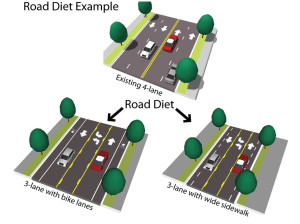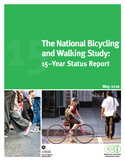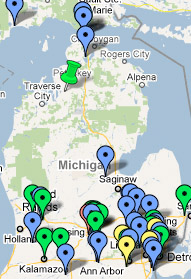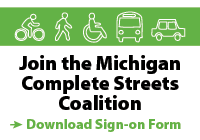You are currently browsing the category archive for the ‘Resources’ category.
 The Michigan Chapter of the American Planning Association published an extensive and explanatory article about complete streets in its monthly magazine, the Michigan Planner. A word version of the article, written by Brad Strader, can be downloaded here. Great work!
The Michigan Chapter of the American Planning Association published an extensive and explanatory article about complete streets in its monthly magazine, the Michigan Planner. A word version of the article, written by Brad Strader, can be downloaded here. Great work!
Here’s a cool blog post and infographic from good.is on the rising popularity of people powered transportation. With the Michigan House of Representatives scheduled to vote on the Complete Streets legislation, this is particularly timely. Passing the legislation will make it even easier for Michigan citizens to continue to increasingly choose walking and biking over automobiles.
“It’s summer, and you may be seeing more people out on the street walking and biking. But it’s not just because the weather is nice. There are more people walking and biking year round, and the Department of Transportation is responding by dramatically increasing the amount of money spent on projects for pedestrians and cyclists.”
 The infographic is derived from the 15-year Status Report, which is the third status update to the National Bicycling and Walking Study, originally published in 1994 as an assessment of bicycling and walking as transportation modes in the United States. The report gives an update on the two main goals of the 1994 study: reducing fatalities and increasing the number of trips made by walking and biking. The good news is that improvements were made in both, but funding for these alternatives to automobiles still accounts for only about 2% of transportation funding, so there’s still some work to do. The report also notes that “one of the fastest-growing efforts to promote bicycling and walking is the adoption of Complete Streets policies.”
The infographic is derived from the 15-year Status Report, which is the third status update to the National Bicycling and Walking Study, originally published in 1994 as an assessment of bicycling and walking as transportation modes in the United States. The report gives an update on the two main goals of the 1994 study: reducing fatalities and increasing the number of trips made by walking and biking. The good news is that improvements were made in both, but funding for these alternatives to automobiles still accounts for only about 2% of transportation funding, so there’s still some work to do. The report also notes that “one of the fastest-growing efforts to promote bicycling and walking is the adoption of Complete Streets policies.”
The map below highlights the various businesses and organizations throughout the state who have joined the MI Complete Streets Coalition.
Legend:
| Category | National and/or Statewide | Regional and/or Local |
| Environmental/Land Use | ||
| Disability/Aging | ||
| Bicycling | ||
| Health/Wellness | ||
| Transit | ||
| Engineering/Planning | ||
| Trails | ||
| Economic/Development | ||
| Other |
Want to get your organization on the map? Join the MI Complete Streets Coalition today!
 In 2010, the Cardiovascular Health, Physical Activity and Nutrition Section at the Michigan Department of Community Health (MDCH) in partnership with Healthy Kids, Healthy Michigan Coalition received a grant from the American Recovery and Reinvestment Act (ARRA) at the Centers for Disease Control and Prevention to support the passage of a state level complete streets resolution and future legislation. The funding is also intended to support efforts by local health departments to pass complete streets ordinances in their communities.
In 2010, the Cardiovascular Health, Physical Activity and Nutrition Section at the Michigan Department of Community Health (MDCH) in partnership with Healthy Kids, Healthy Michigan Coalition received a grant from the American Recovery and Reinvestment Act (ARRA) at the Centers for Disease Control and Prevention to support the passage of a state level complete streets resolution and future legislation. The funding is also intended to support efforts by local health departments to pass complete streets ordinances in their communities.
Michigan Department of Community Health is also contributing additional funding to the effort. Seven health departments were awarded grants of $12,000 a piece to support local complete streets efforts.
“Passage of complete streets ordinances will help insure that our communities accommodate all forms of transportation and not just automobiles,” said Lisa Grost, Public Health Consultant for MDCH. “Increasing safety for pedestrians and bicyclists and improving physical activity levels through active infrastructure is a win-win for Michigan communities.”
For the 2010 grant year, the following local health departments and communities have been awarded the ARRA-Complete Streets grant:
| Local Health Department | Community |
| Detroit Department of Health and Wellness Promotion | City of Detroit |
| Washtenaw County Health Department | City of Saline |
| Ingham County Health Department | City of East Lansing |
| Western U.P County Health Department | City of Houghton |
| Marquette County Health Department | Marquette Township |
| Genesee County Health Department | City of Flint and City of Linden |
| Jackson County Health Department | City of Jackson |
Information and Findings from the Alliance for Walking & Biking
Bicycling and Walking in the U.S.: 2010 Benchmarking Report is an essential resource and tool for government officials, advocates, and those working to promote bicycling and walking. The Benchmarking Project is an on-going effort to collect and analyze data on bicycling and walking in all 50 states and the 51 largest U.S. cities. This second biennial report reveals data including: bicycling and walking levels and demographics; bicycle and pedestrian safety; bicycle and pedestrian policies and provisions; funding for bicycle and pedestrian projects; bicycle and pedestrian staffing levels; written policies on bicycling and walking; bicycle infrastructure including bike lanes, paths, signed bike routes, and bicycle parking; bike-transit integration including presence of bike racks on buses, bike parking at transit stops; bicycling and walking education and encouragement activities; and public health indicators including levels of obesity, physical activity, diabetes, and high blood pressure. The report is full of data tables and graphs so you can see how your state or city stacks up. Inside you will find unprecedented statistics to help support your case for increasing safe bicycling and walking in your community. Bicycling and Walking in the U.S.: 2010 Benchmarking Report was funded by the Centers for Disease Control and Prevention and made possible through the additional support of Bikes Belong and Planet Bike.
Taking a stroll? Ann Arbor is the safest city in Michigan to do it, while Flint is the most dangerous according to a national report released today.
Overall, the number pedestrians killed each year in Michigan is above the national average (12.2% in Michigan, compared with 11.8% nationally). Cities including Lansing, Grand Rapids and Jackson scored favorably, while Detroit, Monroe, and others scored well below the national average. Click here for the complete data on Michigan.
More than 4,500 Americans died last year while walking in the nation’s cities and towns. In Michigan, 253 pedestrian fatalities were recorded in 2007 and 2008.
The report—Dangerous by Design: Solving the Epidemic of Preventable Pedestrian Deaths—was authored by Transportation for America and the Surface Transportation Policy Partnership. It was released in Michigan through the Michigan Environmental Council.
The report shows that communities that invest in safe, complete streets — those that encourage pedestrians, cyclists and motorists to coexist safely — are the safest places to walk. Walk- friendly policies and infrastructure should be a key pillar of policies to encourage revitalization of urban cores throughout the state.
Unfortunately, only a trickle of transportation funding is used to address pedestrian safety. Pedestrian deaths account for 12 percent of all traffic deaths, yet only 1.5 percent of funds available in the current federal transportation bill are directed toward pedestrian safety.
 The American Planning Association and the National Complete Streets Coalition have launched a research project on complete streets. The effort is intended to transform community planning, urban design, and engineering street design practices to better meet the needs of all forms of vehicular and non-vehicular transportation — cars, transit, pedestrians, (including pedestrians with disabilities), and bicyclists.
The American Planning Association and the National Complete Streets Coalition have launched a research project on complete streets. The effort is intended to transform community planning, urban design, and engineering street design practices to better meet the needs of all forms of vehicular and non-vehicular transportation — cars, transit, pedestrians, (including pedestrians with disabilities), and bicyclists.
You can learn more about this great new resource at: http://www.planning.org/research/streets/
Below is a map of current Complete Streets policies and nonmotorized plans that are in place throughout Michigan. Click the icons below for links to more information on each item. Please contact us if your community has a plan or policy to add.

























